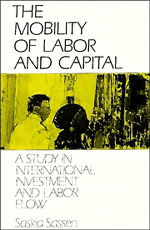Book contents
- Frontmatter
- Contents
- List of tables
- Acknowledgements
- Introduction
- 1 Foreign investment: a neglected variable
- 2 The use of foreign workers
- 3 The new immigration
- 4 The globalization of production: implications for labor migration
- 5 The rise of global cities and the new labor demand
- 6 The reconcentration of capital in the United States: a new investment zone?
- Conclusion
- Notes
- References
- Index
5 - The rise of global cities and the new labor demand
Published online by Cambridge University Press: 04 April 2011
- Frontmatter
- Contents
- List of tables
- Acknowledgements
- Introduction
- 1 Foreign investment: a neglected variable
- 2 The use of foreign workers
- 3 The new immigration
- 4 The globalization of production: implications for labor migration
- 5 The rise of global cities and the new labor demand
- 6 The reconcentration of capital in the United States: a new investment zone?
- Conclusion
- Notes
- References
- Index
Summary
The developments described in the preceding chapter contribute to explain the emergence of new migration streams to the United States. The developments addressed in this chapter contribute to explain the continuation of these migrations at increasing levels. That is to say, the preceding chapter identified conditions for the formation of a migrant labor supply in the sending countries, while the current chapter focuses on the conditions influencing the demand for an immigrant workforce in what have become key destinations of these migrations.
The new industrialization in several Asian and Caribbean countries is in good part the other side of what the U.S. experiences as deindustrialization. These shifts are one aspect of the territorial decentralization of economic activity generally. Decentralization and the technical transformation of work have contributed to the development of a new core economic base in highly industrialized countries. This new core consists of highly specialized services, the corporate headquarters complex, and high technology industries, and it promptly evokes images of high-level, specialized jobs. However, this is only part of the actual situation: the new economy has also generated a massive expansion in the supply of low-wage jobs.
For a number of reasons, these new trends are particularly accentuated in major urban centers, which are also the destination of the vast majority of new immigrants. They have intensified the role of major cities as producers and exporters of specialized services and of high-level managerial inputs.
- Type
- Chapter
- Information
- The Mobility of Labor and CapitalA Study in International Investment and Labor Flow, pp. 126 - 170Publisher: Cambridge University PressPrint publication year: 1988
- 2
- Cited by



